Organisational Behaviour Analysis: Tesco's Culture and Motivation
VerifiedAdded on 2020/07/23
|10
|2753
|57
Report
AI Summary
This report provides an analysis of organisational behaviour within Tesco, a global retail company. It explores how culture, power, and politics influence team behaviour, examining concepts like Handy's culture typology and Hofstede's cultural dimensions. The report also delves into content and process theories of motivation, including Herzberg's and Maslow's theories, alongside extrinsic and intrinsic motivational techniques used by Tesco. Furthermore, it covers additional motivational theories, such as Vroom's expectancy theory and attribution theory, highlighting how these elements contribute to employee performance and overall organisational success. The analysis emphasizes how Tesco employs these strategies to maintain employee relations and achieve its business objectives.
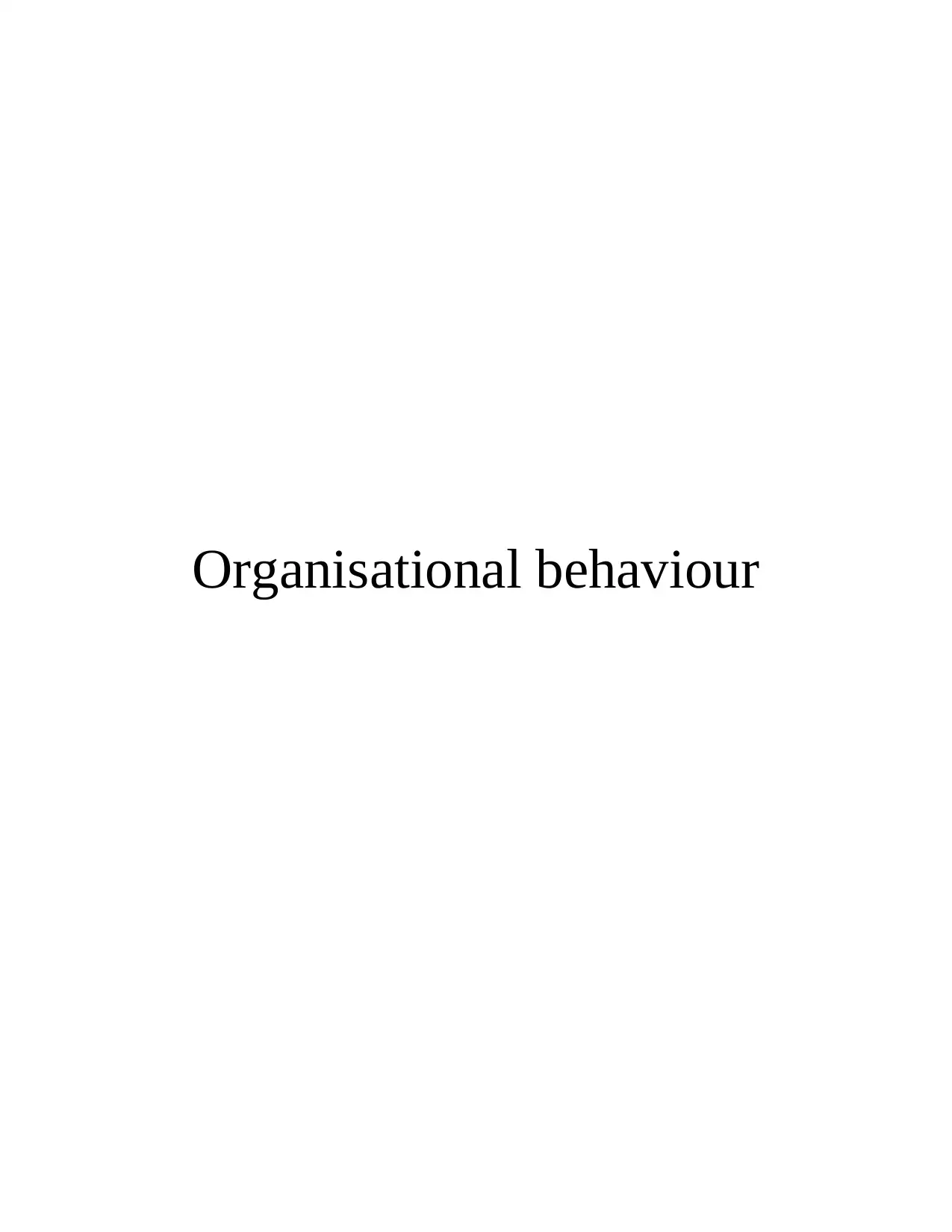
Organisational behaviour
Paraphrase This Document
Need a fresh take? Get an instant paraphrase of this document with our AI Paraphraser
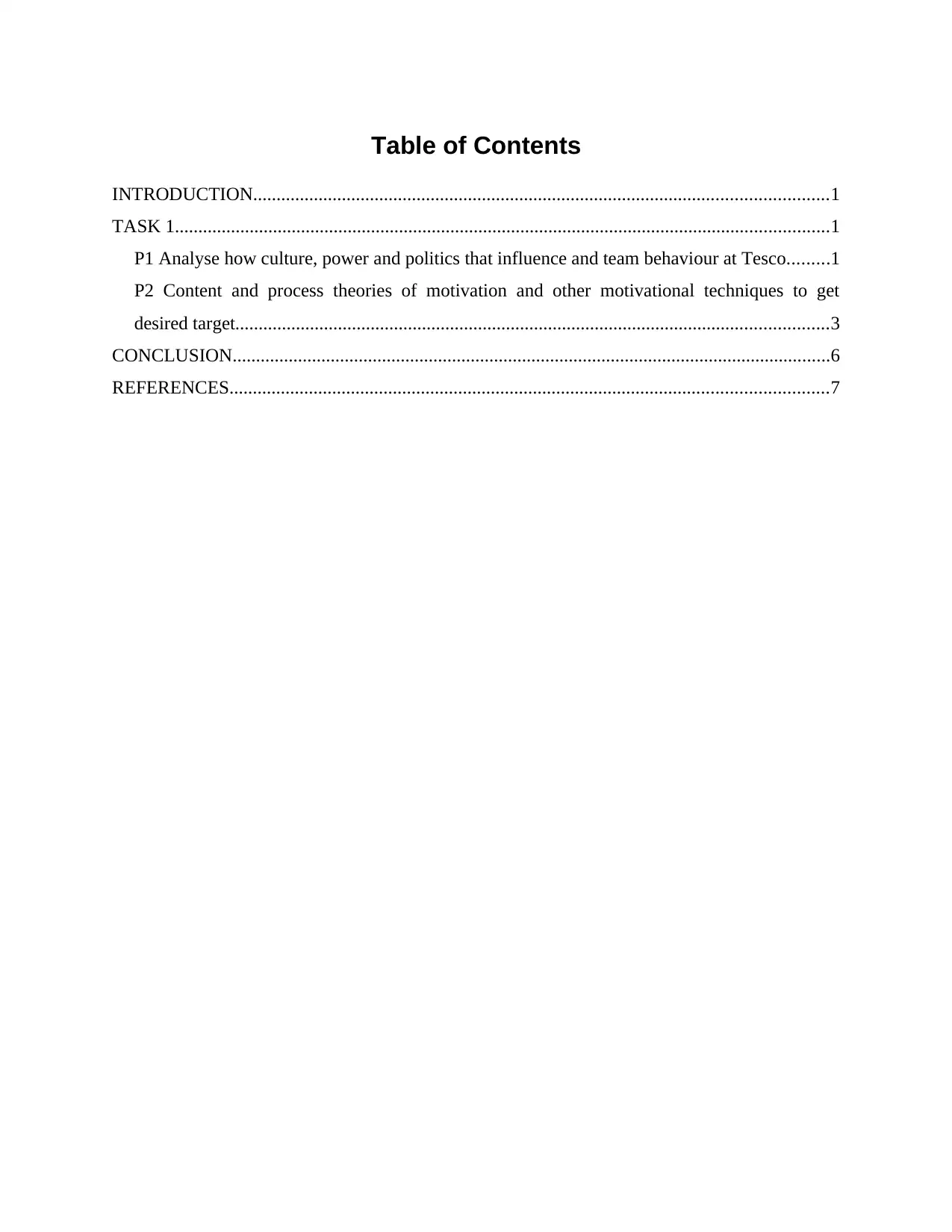
Table of Contents
INTRODUCTION...........................................................................................................................1
TASK 1............................................................................................................................................1
P1 Analyse how culture, power and politics that influence and team behaviour at Tesco.........1
P2 Content and process theories of motivation and other motivational techniques to get
desired target...............................................................................................................................3
CONCLUSION................................................................................................................................6
REFERENCES................................................................................................................................7
INTRODUCTION...........................................................................................................................1
TASK 1............................................................................................................................................1
P1 Analyse how culture, power and politics that influence and team behaviour at Tesco.........1
P2 Content and process theories of motivation and other motivational techniques to get
desired target...............................................................................................................................3
CONCLUSION................................................................................................................................6
REFERENCES................................................................................................................................7
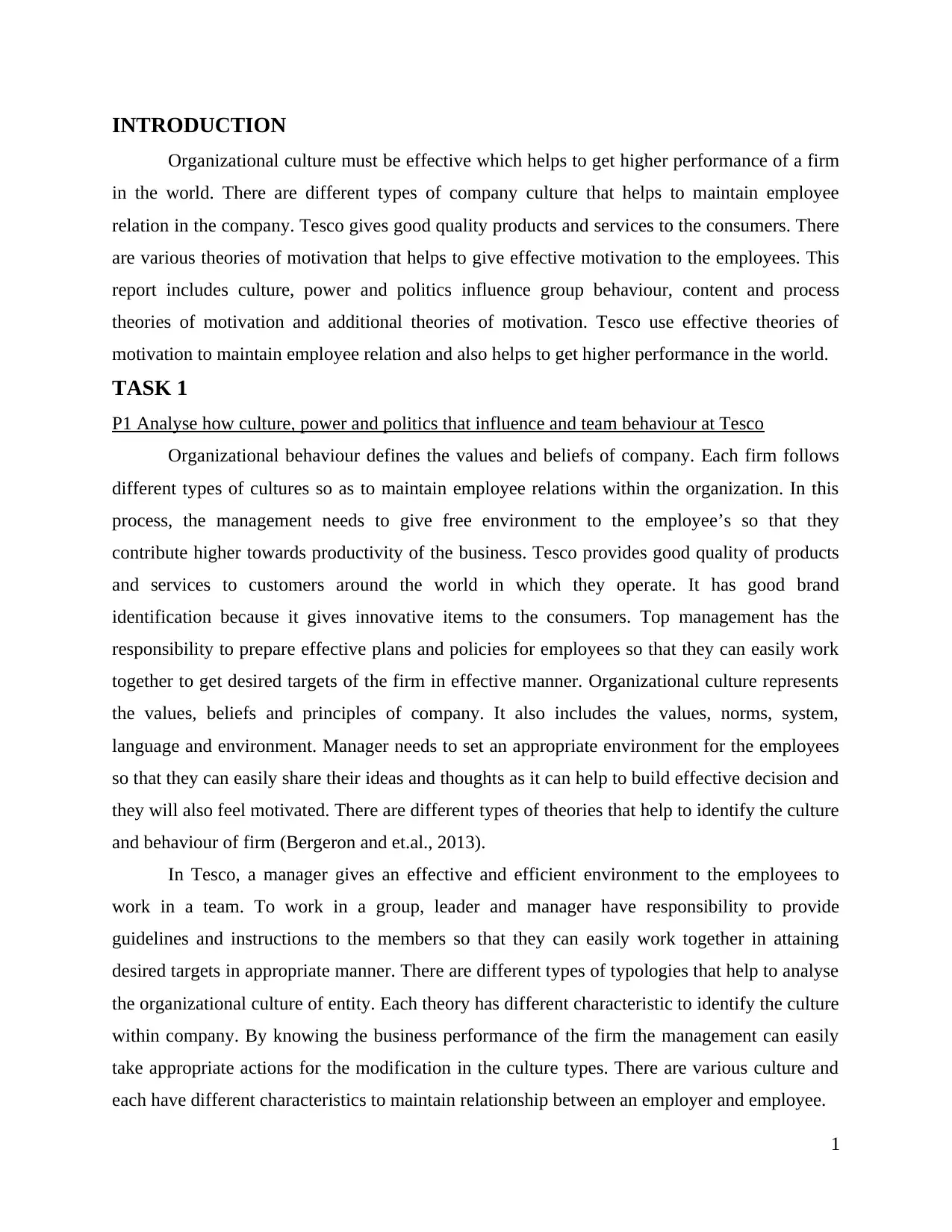
INTRODUCTION
Organizational culture must be effective which helps to get higher performance of a firm
in the world. There are different types of company culture that helps to maintain employee
relation in the company. Tesco gives good quality products and services to the consumers. There
are various theories of motivation that helps to give effective motivation to the employees. This
report includes culture, power and politics influence group behaviour, content and process
theories of motivation and additional theories of motivation. Tesco use effective theories of
motivation to maintain employee relation and also helps to get higher performance in the world.
TASK 1
P1 Analyse how culture, power and politics that influence and team behaviour at Tesco
Organizational behaviour defines the values and beliefs of company. Each firm follows
different types of cultures so as to maintain employee relations within the organization. In this
process, the management needs to give free environment to the employee’s so that they
contribute higher towards productivity of the business. Tesco provides good quality of products
and services to customers around the world in which they operate. It has good brand
identification because it gives innovative items to the consumers. Top management has the
responsibility to prepare effective plans and policies for employees so that they can easily work
together to get desired targets of the firm in effective manner. Organizational culture represents
the values, beliefs and principles of company. It also includes the values, norms, system,
language and environment. Manager needs to set an appropriate environment for the employees
so that they can easily share their ideas and thoughts as it can help to build effective decision and
they will also feel motivated. There are different types of theories that help to identify the culture
and behaviour of firm (Bergeron and et.al., 2013).
In Tesco, a manager gives an effective and efficient environment to the employees to
work in a team. To work in a group, leader and manager have responsibility to provide
guidelines and instructions to the members so that they can easily work together in attaining
desired targets in appropriate manner. There are different types of typologies that help to analyse
the organizational culture of entity. Each theory has different characteristic to identify the culture
within company. By knowing the business performance of the firm the management can easily
take appropriate actions for the modification in the culture types. There are various culture and
each have different characteristics to maintain relationship between an employer and employee.
1
Organizational culture must be effective which helps to get higher performance of a firm
in the world. There are different types of company culture that helps to maintain employee
relation in the company. Tesco gives good quality products and services to the consumers. There
are various theories of motivation that helps to give effective motivation to the employees. This
report includes culture, power and politics influence group behaviour, content and process
theories of motivation and additional theories of motivation. Tesco use effective theories of
motivation to maintain employee relation and also helps to get higher performance in the world.
TASK 1
P1 Analyse how culture, power and politics that influence and team behaviour at Tesco
Organizational behaviour defines the values and beliefs of company. Each firm follows
different types of cultures so as to maintain employee relations within the organization. In this
process, the management needs to give free environment to the employee’s so that they
contribute higher towards productivity of the business. Tesco provides good quality of products
and services to customers around the world in which they operate. It has good brand
identification because it gives innovative items to the consumers. Top management has the
responsibility to prepare effective plans and policies for employees so that they can easily work
together to get desired targets of the firm in effective manner. Organizational culture represents
the values, beliefs and principles of company. It also includes the values, norms, system,
language and environment. Manager needs to set an appropriate environment for the employees
so that they can easily share their ideas and thoughts as it can help to build effective decision and
they will also feel motivated. There are different types of theories that help to identify the culture
and behaviour of firm (Bergeron and et.al., 2013).
In Tesco, a manager gives an effective and efficient environment to the employees to
work in a team. To work in a group, leader and manager have responsibility to provide
guidelines and instructions to the members so that they can easily work together in attaining
desired targets in appropriate manner. There are different types of typologies that help to analyse
the organizational culture of entity. Each theory has different characteristic to identify the culture
within company. By knowing the business performance of the firm the management can easily
take appropriate actions for the modification in the culture types. There are various culture and
each have different characteristics to maintain relationship between an employer and employee.
1
⊘ This is a preview!⊘
Do you want full access?
Subscribe today to unlock all pages.

Trusted by 1+ million students worldwide
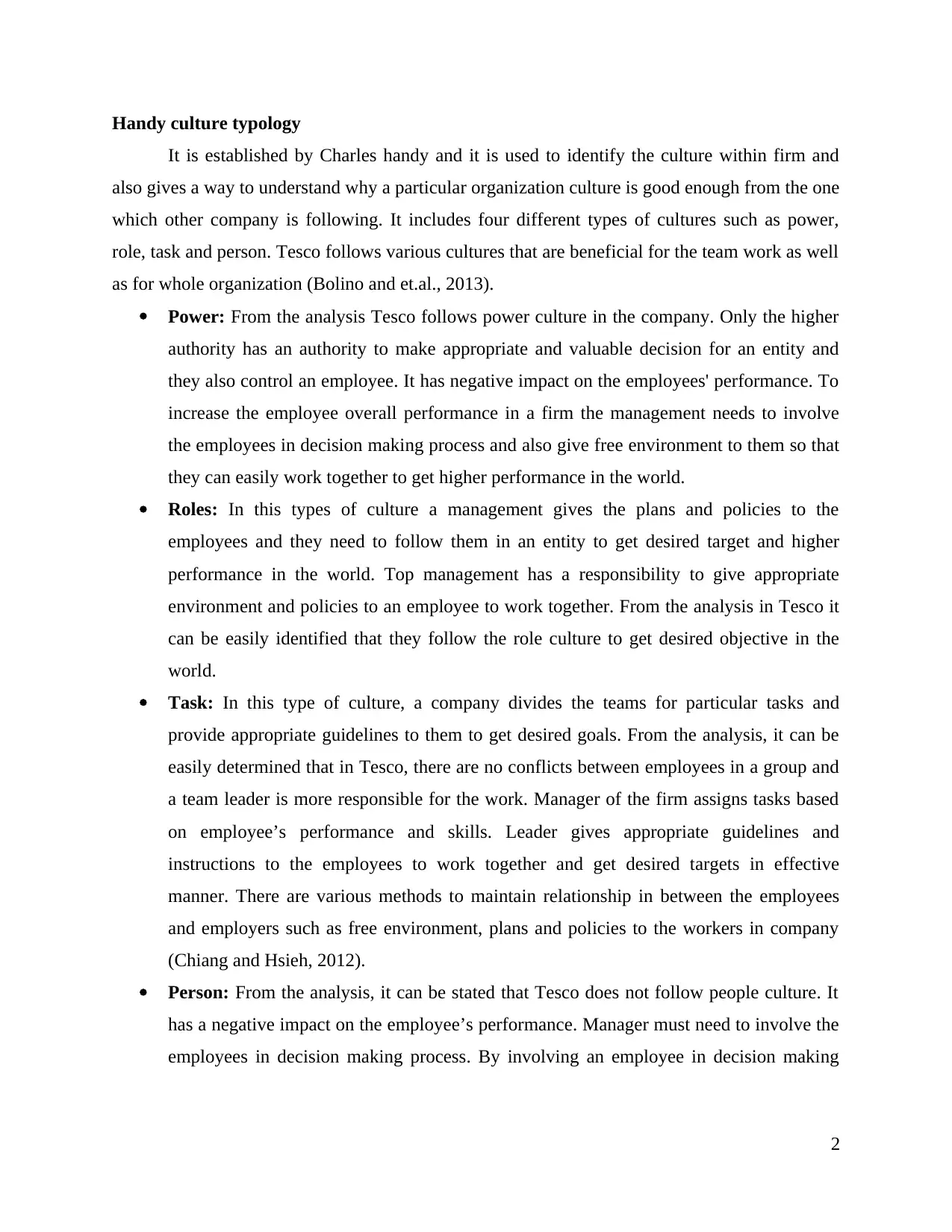
Handy culture typology
It is established by Charles handy and it is used to identify the culture within firm and
also gives a way to understand why a particular organization culture is good enough from the one
which other company is following. It includes four different types of cultures such as power,
role, task and person. Tesco follows various cultures that are beneficial for the team work as well
as for whole organization (Bolino and et.al., 2013).
Power: From the analysis Tesco follows power culture in the company. Only the higher
authority has an authority to make appropriate and valuable decision for an entity and
they also control an employee. It has negative impact on the employees' performance. To
increase the employee overall performance in a firm the management needs to involve
the employees in decision making process and also give free environment to them so that
they can easily work together to get higher performance in the world.
Roles: In this types of culture a management gives the plans and policies to the
employees and they need to follow them in an entity to get desired target and higher
performance in the world. Top management has a responsibility to give appropriate
environment and policies to an employee to work together. From the analysis in Tesco it
can be easily identified that they follow the role culture to get desired objective in the
world.
Task: In this type of culture, a company divides the teams for particular tasks and
provide appropriate guidelines to them to get desired goals. From the analysis, it can be
easily determined that in Tesco, there are no conflicts between employees in a group and
a team leader is more responsible for the work. Manager of the firm assigns tasks based
on employee’s performance and skills. Leader gives appropriate guidelines and
instructions to the employees to work together and get desired targets in effective
manner. There are various methods to maintain relationship in between the employees
and employers such as free environment, plans and policies to the workers in company
(Chiang and Hsieh, 2012).
Person: From the analysis, it can be stated that Tesco does not follow people culture. It
has a negative impact on the employee’s performance. Manager must need to involve the
employees in decision making process. By involving an employee in decision making
2
It is established by Charles handy and it is used to identify the culture within firm and
also gives a way to understand why a particular organization culture is good enough from the one
which other company is following. It includes four different types of cultures such as power,
role, task and person. Tesco follows various cultures that are beneficial for the team work as well
as for whole organization (Bolino and et.al., 2013).
Power: From the analysis Tesco follows power culture in the company. Only the higher
authority has an authority to make appropriate and valuable decision for an entity and
they also control an employee. It has negative impact on the employees' performance. To
increase the employee overall performance in a firm the management needs to involve
the employees in decision making process and also give free environment to them so that
they can easily work together to get higher performance in the world.
Roles: In this types of culture a management gives the plans and policies to the
employees and they need to follow them in an entity to get desired target and higher
performance in the world. Top management has a responsibility to give appropriate
environment and policies to an employee to work together. From the analysis in Tesco it
can be easily identified that they follow the role culture to get desired objective in the
world.
Task: In this type of culture, a company divides the teams for particular tasks and
provide appropriate guidelines to them to get desired goals. From the analysis, it can be
easily determined that in Tesco, there are no conflicts between employees in a group and
a team leader is more responsible for the work. Manager of the firm assigns tasks based
on employee’s performance and skills. Leader gives appropriate guidelines and
instructions to the employees to work together and get desired targets in effective
manner. There are various methods to maintain relationship in between the employees
and employers such as free environment, plans and policies to the workers in company
(Chiang and Hsieh, 2012).
Person: From the analysis, it can be stated that Tesco does not follow people culture. It
has a negative impact on the employee’s performance. Manager must need to involve the
employees in decision making process. By involving an employee in decision making
2
Paraphrase This Document
Need a fresh take? Get an instant paraphrase of this document with our AI Paraphraser
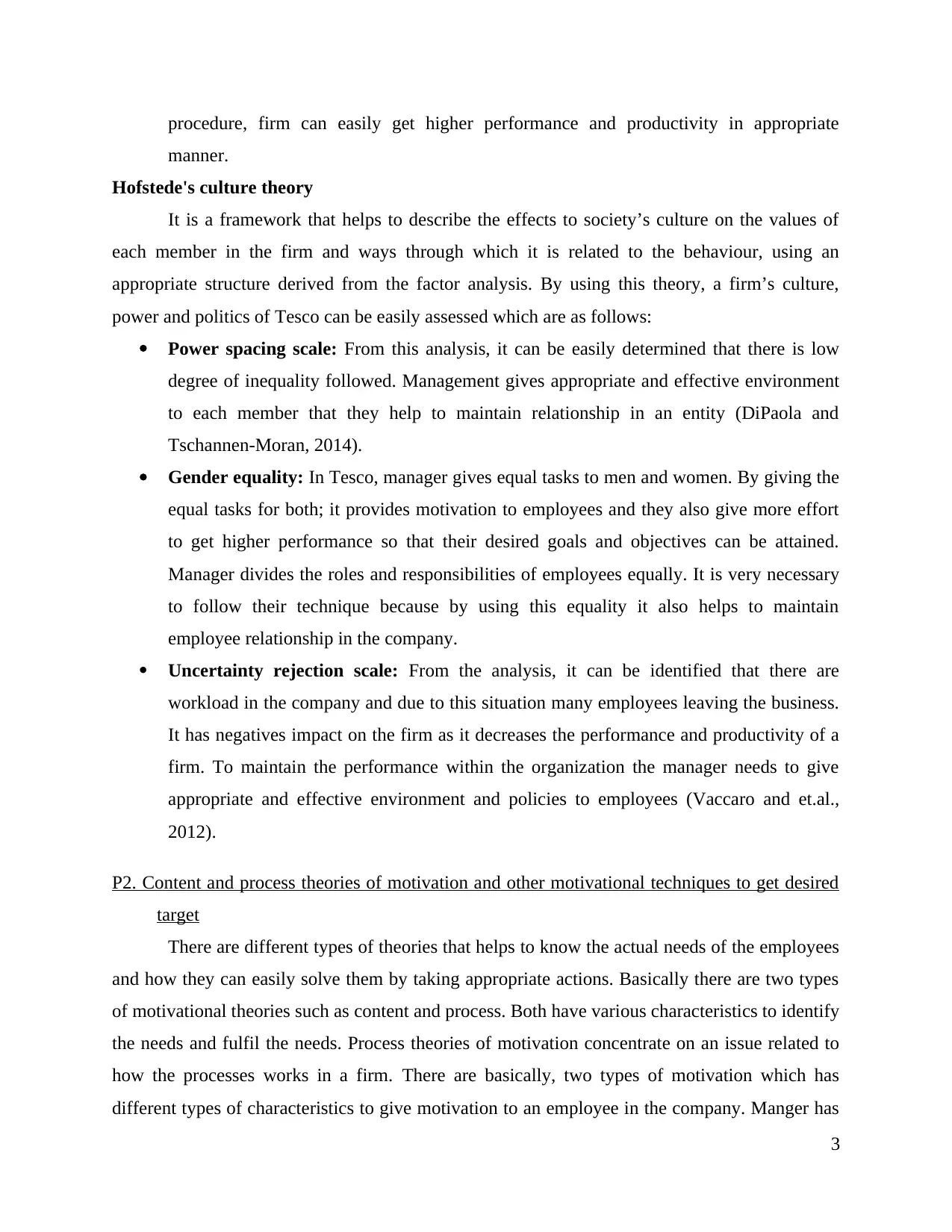
procedure, firm can easily get higher performance and productivity in appropriate
manner.
Hofstede's culture theory
It is a framework that helps to describe the effects to society’s culture on the values of
each member in the firm and ways through which it is related to the behaviour, using an
appropriate structure derived from the factor analysis. By using this theory, a firm’s culture,
power and politics of Tesco can be easily assessed which are as follows:
Power spacing scale: From this analysis, it can be easily determined that there is low
degree of inequality followed. Management gives appropriate and effective environment
to each member that they help to maintain relationship in an entity (DiPaola and
Tschannen-Moran, 2014).
Gender equality: In Tesco, manager gives equal tasks to men and women. By giving the
equal tasks for both; it provides motivation to employees and they also give more effort
to get higher performance so that their desired goals and objectives can be attained.
Manager divides the roles and responsibilities of employees equally. It is very necessary
to follow their technique because by using this equality it also helps to maintain
employee relationship in the company.
Uncertainty rejection scale: From the analysis, it can be identified that there are
workload in the company and due to this situation many employees leaving the business.
It has negatives impact on the firm as it decreases the performance and productivity of a
firm. To maintain the performance within the organization the manager needs to give
appropriate and effective environment and policies to employees (Vaccaro and et.al.,
2012).
P2. Content and process theories of motivation and other motivational techniques to get desired
target
There are different types of theories that helps to know the actual needs of the employees
and how they can easily solve them by taking appropriate actions. Basically there are two types
of motivational theories such as content and process. Both have various characteristics to identify
the needs and fulfil the needs. Process theories of motivation concentrate on an issue related to
how the processes works in a firm. There are basically, two types of motivation which has
different types of characteristics to give motivation to an employee in the company. Manger has
3
manner.
Hofstede's culture theory
It is a framework that helps to describe the effects to society’s culture on the values of
each member in the firm and ways through which it is related to the behaviour, using an
appropriate structure derived from the factor analysis. By using this theory, a firm’s culture,
power and politics of Tesco can be easily assessed which are as follows:
Power spacing scale: From this analysis, it can be easily determined that there is low
degree of inequality followed. Management gives appropriate and effective environment
to each member that they help to maintain relationship in an entity (DiPaola and
Tschannen-Moran, 2014).
Gender equality: In Tesco, manager gives equal tasks to men and women. By giving the
equal tasks for both; it provides motivation to employees and they also give more effort
to get higher performance so that their desired goals and objectives can be attained.
Manager divides the roles and responsibilities of employees equally. It is very necessary
to follow their technique because by using this equality it also helps to maintain
employee relationship in the company.
Uncertainty rejection scale: From the analysis, it can be identified that there are
workload in the company and due to this situation many employees leaving the business.
It has negatives impact on the firm as it decreases the performance and productivity of a
firm. To maintain the performance within the organization the manager needs to give
appropriate and effective environment and policies to employees (Vaccaro and et.al.,
2012).
P2. Content and process theories of motivation and other motivational techniques to get desired
target
There are different types of theories that helps to know the actual needs of the employees
and how they can easily solve them by taking appropriate actions. Basically there are two types
of motivational theories such as content and process. Both have various characteristics to identify
the needs and fulfil the needs. Process theories of motivation concentrate on an issue related to
how the processes works in a firm. There are basically, two types of motivation which has
different types of characteristics to give motivation to an employee in the company. Manger has
3
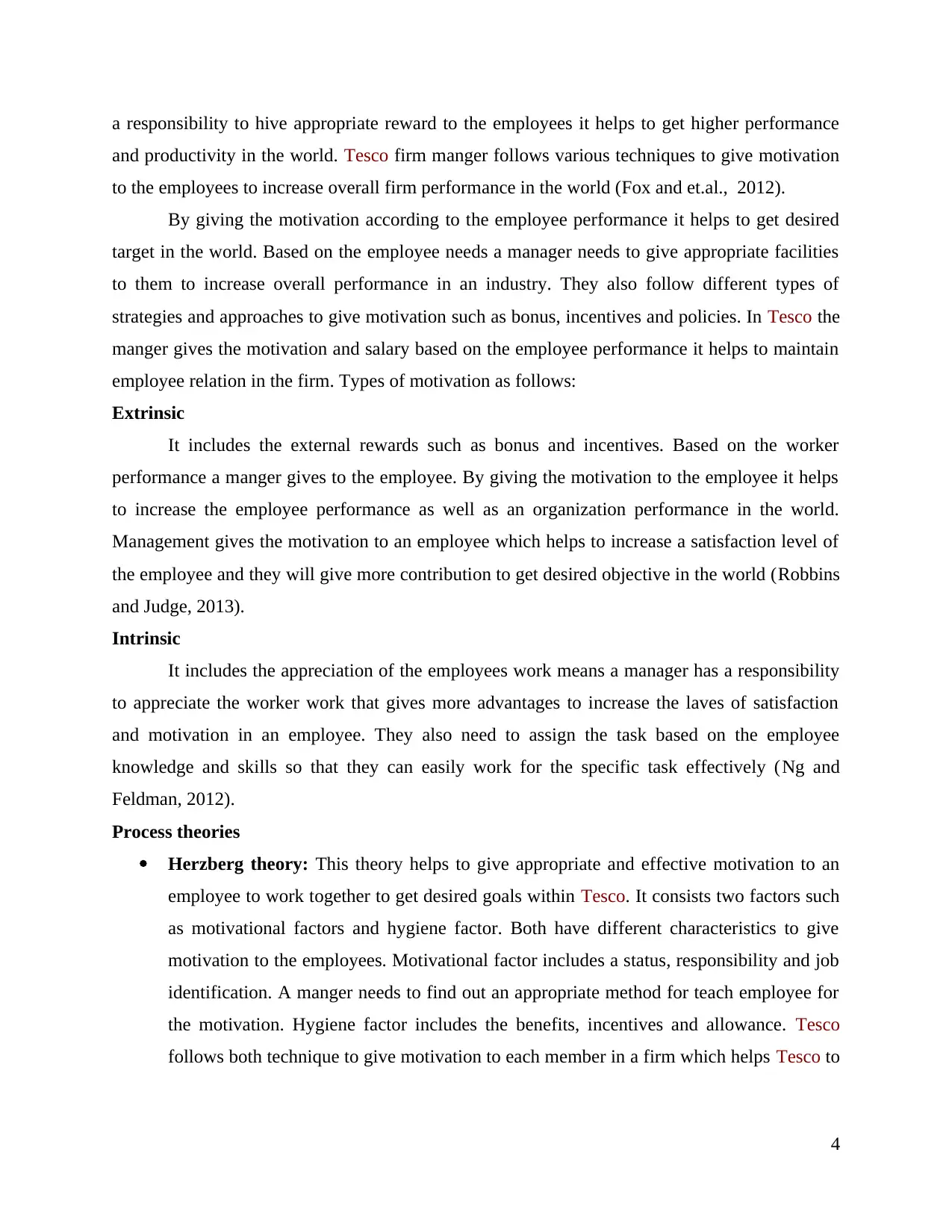
a responsibility to hive appropriate reward to the employees it helps to get higher performance
and productivity in the world. Tesco firm manger follows various techniques to give motivation
to the employees to increase overall firm performance in the world (Fox and et.al., 2012).
By giving the motivation according to the employee performance it helps to get desired
target in the world. Based on the employee needs a manager needs to give appropriate facilities
to them to increase overall performance in an industry. They also follow different types of
strategies and approaches to give motivation such as bonus, incentives and policies. In Tesco the
manger gives the motivation and salary based on the employee performance it helps to maintain
employee relation in the firm. Types of motivation as follows:
Extrinsic
It includes the external rewards such as bonus and incentives. Based on the worker
performance a manger gives to the employee. By giving the motivation to the employee it helps
to increase the employee performance as well as an organization performance in the world.
Management gives the motivation to an employee which helps to increase a satisfaction level of
the employee and they will give more contribution to get desired objective in the world (Robbins
and Judge, 2013).
Intrinsic
It includes the appreciation of the employees work means a manager has a responsibility
to appreciate the worker work that gives more advantages to increase the laves of satisfaction
and motivation in an employee. They also need to assign the task based on the employee
knowledge and skills so that they can easily work for the specific task effectively (Ng and
Feldman, 2012).
Process theories
Herzberg theory: This theory helps to give appropriate and effective motivation to an
employee to work together to get desired goals within Tesco. It consists two factors such
as motivational factors and hygiene factor. Both have different characteristics to give
motivation to the employees. Motivational factor includes a status, responsibility and job
identification. A manger needs to find out an appropriate method for teach employee for
the motivation. Hygiene factor includes the benefits, incentives and allowance. Tesco
follows both technique to give motivation to each member in a firm which helps Tesco to
4
and productivity in the world. Tesco firm manger follows various techniques to give motivation
to the employees to increase overall firm performance in the world (Fox and et.al., 2012).
By giving the motivation according to the employee performance it helps to get desired
target in the world. Based on the employee needs a manager needs to give appropriate facilities
to them to increase overall performance in an industry. They also follow different types of
strategies and approaches to give motivation such as bonus, incentives and policies. In Tesco the
manger gives the motivation and salary based on the employee performance it helps to maintain
employee relation in the firm. Types of motivation as follows:
Extrinsic
It includes the external rewards such as bonus and incentives. Based on the worker
performance a manger gives to the employee. By giving the motivation to the employee it helps
to increase the employee performance as well as an organization performance in the world.
Management gives the motivation to an employee which helps to increase a satisfaction level of
the employee and they will give more contribution to get desired objective in the world (Robbins
and Judge, 2013).
Intrinsic
It includes the appreciation of the employees work means a manager has a responsibility
to appreciate the worker work that gives more advantages to increase the laves of satisfaction
and motivation in an employee. They also need to assign the task based on the employee
knowledge and skills so that they can easily work for the specific task effectively (Ng and
Feldman, 2012).
Process theories
Herzberg theory: This theory helps to give appropriate and effective motivation to an
employee to work together to get desired goals within Tesco. It consists two factors such
as motivational factors and hygiene factor. Both have different characteristics to give
motivation to the employees. Motivational factor includes a status, responsibility and job
identification. A manger needs to find out an appropriate method for teach employee for
the motivation. Hygiene factor includes the benefits, incentives and allowance. Tesco
follows both technique to give motivation to each member in a firm which helps Tesco to
4
⊘ This is a preview!⊘
Do you want full access?
Subscribe today to unlock all pages.

Trusted by 1+ million students worldwide
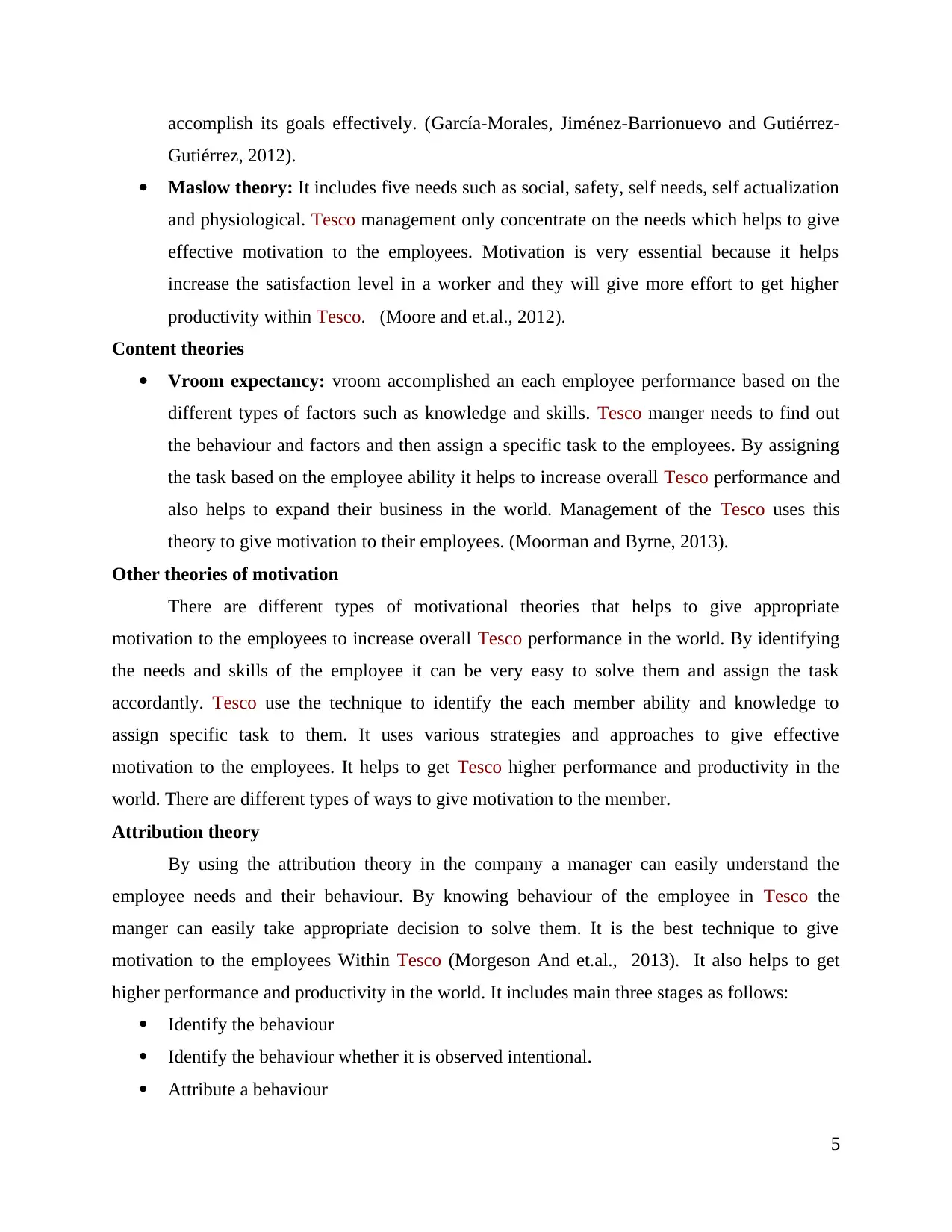
accomplish its goals effectively. (García-Morales, Jiménez-Barrionuevo and Gutiérrez-
Gutiérrez, 2012).
Maslow theory: It includes five needs such as social, safety, self needs, self actualization
and physiological. Tesco management only concentrate on the needs which helps to give
effective motivation to the employees. Motivation is very essential because it helps
increase the satisfaction level in a worker and they will give more effort to get higher
productivity within Tesco. (Moore and et.al., 2012).
Content theories
Vroom expectancy: vroom accomplished an each employee performance based on the
different types of factors such as knowledge and skills. Tesco manger needs to find out
the behaviour and factors and then assign a specific task to the employees. By assigning
the task based on the employee ability it helps to increase overall Tesco performance and
also helps to expand their business in the world. Management of the Tesco uses this
theory to give motivation to their employees. (Moorman and Byrne, 2013).
Other theories of motivation
There are different types of motivational theories that helps to give appropriate
motivation to the employees to increase overall Tesco performance in the world. By identifying
the needs and skills of the employee it can be very easy to solve them and assign the task
accordantly. Tesco use the technique to identify the each member ability and knowledge to
assign specific task to them. It uses various strategies and approaches to give effective
motivation to the employees. It helps to get Tesco higher performance and productivity in the
world. There are different types of ways to give motivation to the member.
Attribution theory
By using the attribution theory in the company a manager can easily understand the
employee needs and their behaviour. By knowing behaviour of the employee in Tesco the
manger can easily take appropriate decision to solve them. It is the best technique to give
motivation to the employees Within Tesco (Morgeson And et.al., 2013). It also helps to get
higher performance and productivity in the world. It includes main three stages as follows:
Identify the behaviour
Identify the behaviour whether it is observed intentional.
Attribute a behaviour
5
Gutiérrez, 2012).
Maslow theory: It includes five needs such as social, safety, self needs, self actualization
and physiological. Tesco management only concentrate on the needs which helps to give
effective motivation to the employees. Motivation is very essential because it helps
increase the satisfaction level in a worker and they will give more effort to get higher
productivity within Tesco. (Moore and et.al., 2012).
Content theories
Vroom expectancy: vroom accomplished an each employee performance based on the
different types of factors such as knowledge and skills. Tesco manger needs to find out
the behaviour and factors and then assign a specific task to the employees. By assigning
the task based on the employee ability it helps to increase overall Tesco performance and
also helps to expand their business in the world. Management of the Tesco uses this
theory to give motivation to their employees. (Moorman and Byrne, 2013).
Other theories of motivation
There are different types of motivational theories that helps to give appropriate
motivation to the employees to increase overall Tesco performance in the world. By identifying
the needs and skills of the employee it can be very easy to solve them and assign the task
accordantly. Tesco use the technique to identify the each member ability and knowledge to
assign specific task to them. It uses various strategies and approaches to give effective
motivation to the employees. It helps to get Tesco higher performance and productivity in the
world. There are different types of ways to give motivation to the member.
Attribution theory
By using the attribution theory in the company a manager can easily understand the
employee needs and their behaviour. By knowing behaviour of the employee in Tesco the
manger can easily take appropriate decision to solve them. It is the best technique to give
motivation to the employees Within Tesco (Morgeson And et.al., 2013). It also helps to get
higher performance and productivity in the world. It includes main three stages as follows:
Identify the behaviour
Identify the behaviour whether it is observed intentional.
Attribute a behaviour
5
Paraphrase This Document
Need a fresh take? Get an instant paraphrase of this document with our AI Paraphraser
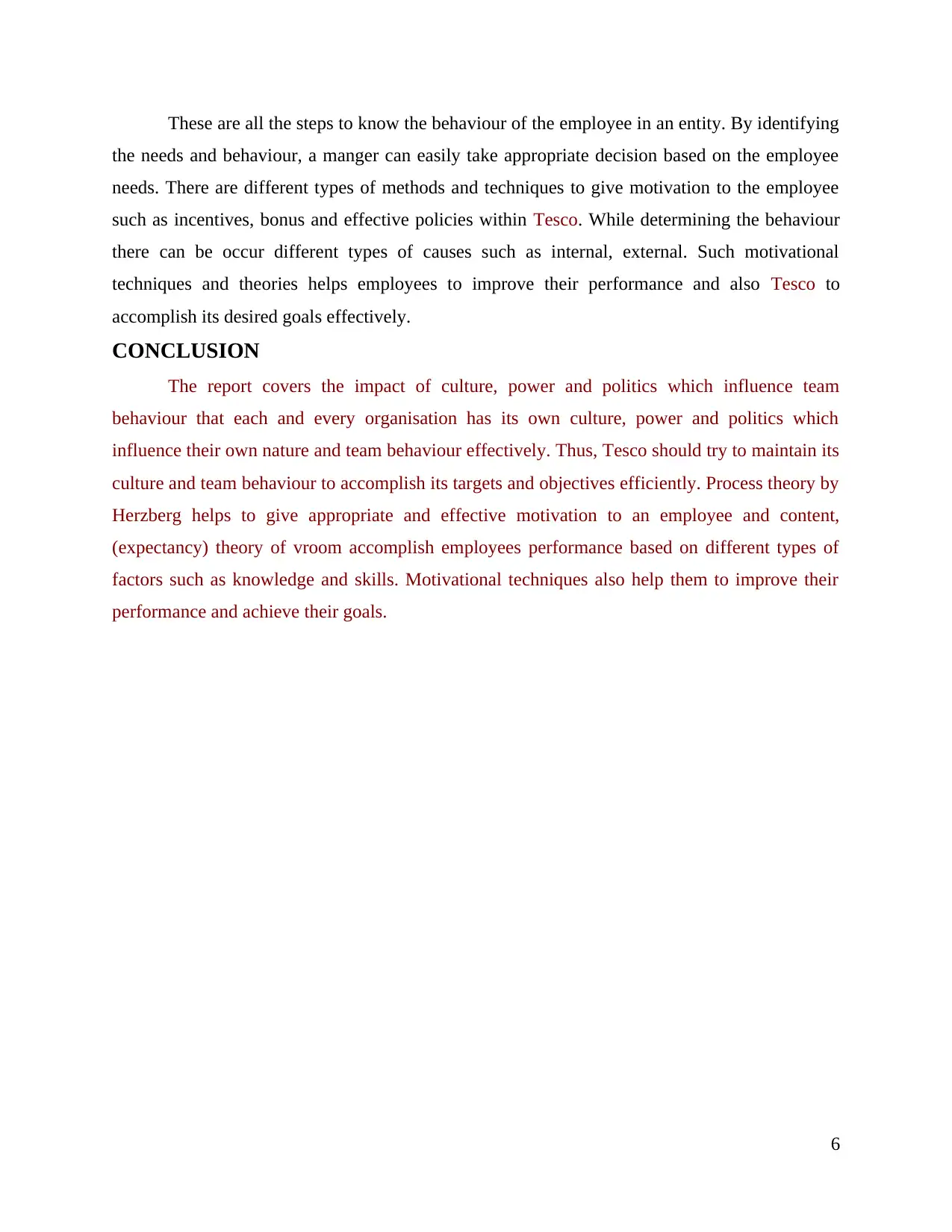
These are all the steps to know the behaviour of the employee in an entity. By identifying
the needs and behaviour, a manger can easily take appropriate decision based on the employee
needs. There are different types of methods and techniques to give motivation to the employee
such as incentives, bonus and effective policies within Tesco. While determining the behaviour
there can be occur different types of causes such as internal, external. Such motivational
techniques and theories helps employees to improve their performance and also Tesco to
accomplish its desired goals effectively.
CONCLUSION
The report covers the impact of culture, power and politics which influence team
behaviour that each and every organisation has its own culture, power and politics which
influence their own nature and team behaviour effectively. Thus, Tesco should try to maintain its
culture and team behaviour to accomplish its targets and objectives efficiently. Process theory by
Herzberg helps to give appropriate and effective motivation to an employee and content,
(expectancy) theory of vroom accomplish employees performance based on different types of
factors such as knowledge and skills. Motivational techniques also help them to improve their
performance and achieve their goals.
6
the needs and behaviour, a manger can easily take appropriate decision based on the employee
needs. There are different types of methods and techniques to give motivation to the employee
such as incentives, bonus and effective policies within Tesco. While determining the behaviour
there can be occur different types of causes such as internal, external. Such motivational
techniques and theories helps employees to improve their performance and also Tesco to
accomplish its desired goals effectively.
CONCLUSION
The report covers the impact of culture, power and politics which influence team
behaviour that each and every organisation has its own culture, power and politics which
influence their own nature and team behaviour effectively. Thus, Tesco should try to maintain its
culture and team behaviour to accomplish its targets and objectives efficiently. Process theory by
Herzberg helps to give appropriate and effective motivation to an employee and content,
(expectancy) theory of vroom accomplish employees performance based on different types of
factors such as knowledge and skills. Motivational techniques also help them to improve their
performance and achieve their goals.
6
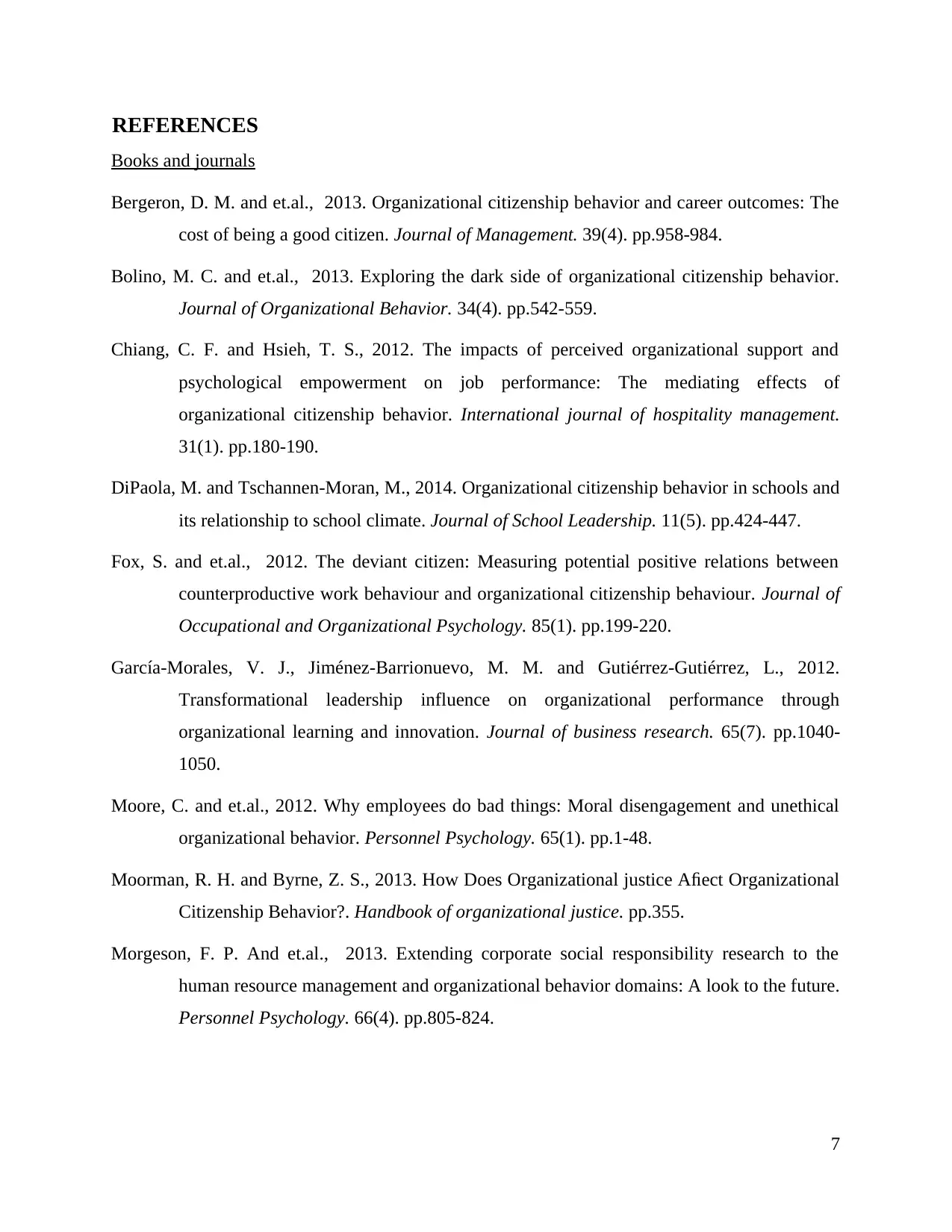
REFERENCES
Books and journals
Bergeron, D. M. and et.al., 2013. Organizational citizenship behavior and career outcomes: The
cost of being a good citizen. Journal of Management. 39(4). pp.958-984.
Bolino, M. C. and et.al., 2013. Exploring the dark side of organizational citizenship behavior.
Journal of Organizational Behavior. 34(4). pp.542-559.
Chiang, C. F. and Hsieh, T. S., 2012. The impacts of perceived organizational support and
psychological empowerment on job performance: The mediating effects of
organizational citizenship behavior. International journal of hospitality management.
31(1). pp.180-190.
DiPaola, M. and Tschannen-Moran, M., 2014. Organizational citizenship behavior in schools and
its relationship to school climate. Journal of School Leadership. 11(5). pp.424-447.
Fox, S. and et.al., 2012. The deviant citizen: Measuring potential positive relations between
counterproductive work behaviour and organizational citizenship behaviour. Journal of
Occupational and Organizational Psychology. 85(1). pp.199-220.
García-Morales, V. J., Jiménez-Barrionuevo, M. M. and Gutiérrez-Gutiérrez, L., 2012.
Transformational leadership influence on organizational performance through
organizational learning and innovation. Journal of business research. 65(7). pp.1040-
1050.
Moore, C. and et.al., 2012. Why employees do bad things: Moral disengagement and unethical
organizational behavior. Personnel Psychology. 65(1). pp.1-48.
Moorman, R. H. and Byrne, Z. S., 2013. How Does Organizational justice Afiect Organizational
Citizenship Behavior?. Handbook of organizational justice. pp.355.
Morgeson, F. P. And et.al., 2013. Extending corporate social responsibility research to the
human resource management and organizational behavior domains: A look to the future.
Personnel Psychology. 66(4). pp.805-824.
7
Books and journals
Bergeron, D. M. and et.al., 2013. Organizational citizenship behavior and career outcomes: The
cost of being a good citizen. Journal of Management. 39(4). pp.958-984.
Bolino, M. C. and et.al., 2013. Exploring the dark side of organizational citizenship behavior.
Journal of Organizational Behavior. 34(4). pp.542-559.
Chiang, C. F. and Hsieh, T. S., 2012. The impacts of perceived organizational support and
psychological empowerment on job performance: The mediating effects of
organizational citizenship behavior. International journal of hospitality management.
31(1). pp.180-190.
DiPaola, M. and Tschannen-Moran, M., 2014. Organizational citizenship behavior in schools and
its relationship to school climate. Journal of School Leadership. 11(5). pp.424-447.
Fox, S. and et.al., 2012. The deviant citizen: Measuring potential positive relations between
counterproductive work behaviour and organizational citizenship behaviour. Journal of
Occupational and Organizational Psychology. 85(1). pp.199-220.
García-Morales, V. J., Jiménez-Barrionuevo, M. M. and Gutiérrez-Gutiérrez, L., 2012.
Transformational leadership influence on organizational performance through
organizational learning and innovation. Journal of business research. 65(7). pp.1040-
1050.
Moore, C. and et.al., 2012. Why employees do bad things: Moral disengagement and unethical
organizational behavior. Personnel Psychology. 65(1). pp.1-48.
Moorman, R. H. and Byrne, Z. S., 2013. How Does Organizational justice Afiect Organizational
Citizenship Behavior?. Handbook of organizational justice. pp.355.
Morgeson, F. P. And et.al., 2013. Extending corporate social responsibility research to the
human resource management and organizational behavior domains: A look to the future.
Personnel Psychology. 66(4). pp.805-824.
7
⊘ This is a preview!⊘
Do you want full access?
Subscribe today to unlock all pages.

Trusted by 1+ million students worldwide
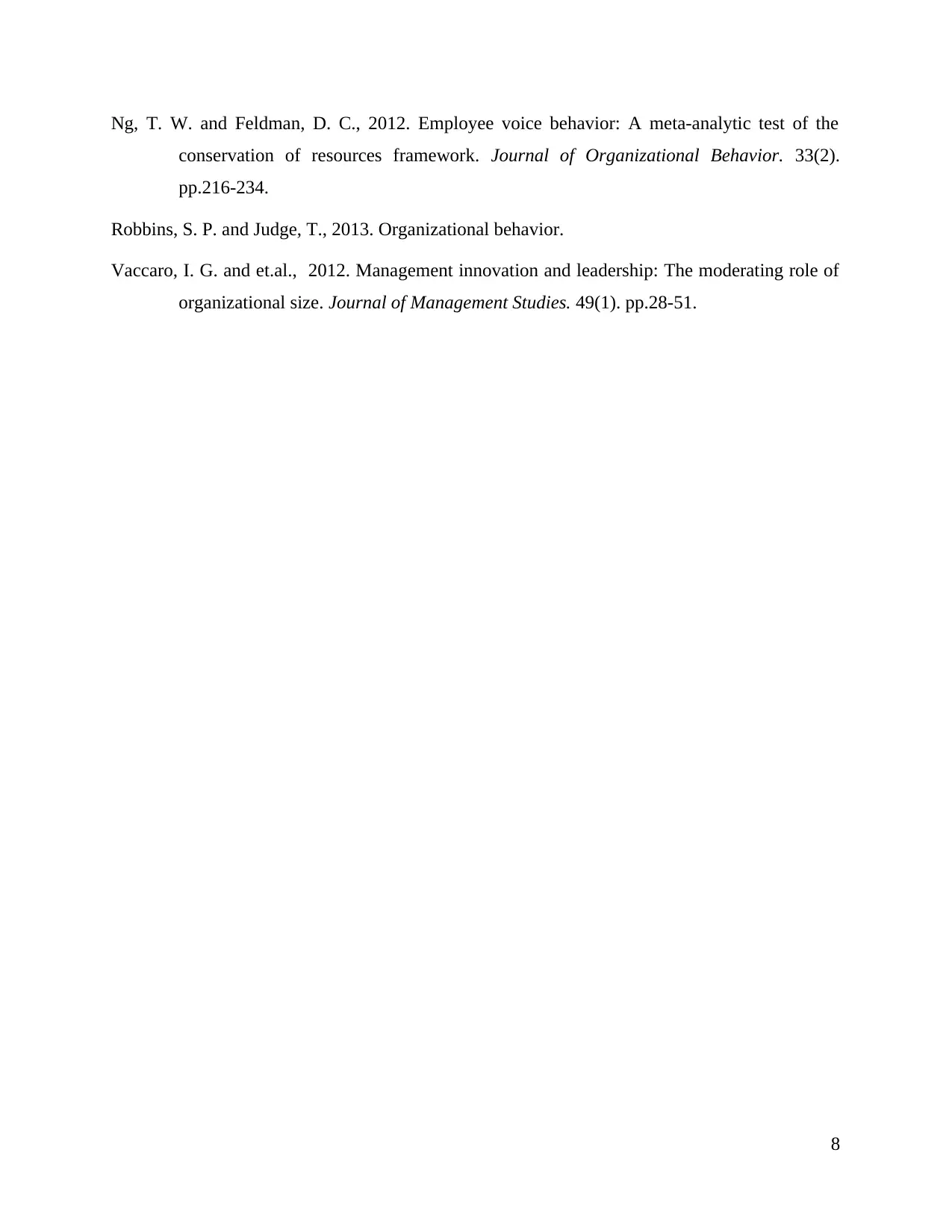
Ng, T. W. and Feldman, D. C., 2012. Employee voice behavior: A meta‐analytic test of the
conservation of resources framework. Journal of Organizational Behavior. 33(2).
pp.216-234.
Robbins, S. P. and Judge, T., 2013. Organizational behavior.
Vaccaro, I. G. and et.al., 2012. Management innovation and leadership: The moderating role of
organizational size. Journal of Management Studies. 49(1). pp.28-51.
8
conservation of resources framework. Journal of Organizational Behavior. 33(2).
pp.216-234.
Robbins, S. P. and Judge, T., 2013. Organizational behavior.
Vaccaro, I. G. and et.al., 2012. Management innovation and leadership: The moderating role of
organizational size. Journal of Management Studies. 49(1). pp.28-51.
8
1 out of 10
Related Documents
Your All-in-One AI-Powered Toolkit for Academic Success.
+13062052269
info@desklib.com
Available 24*7 on WhatsApp / Email
![[object Object]](/_next/static/media/star-bottom.7253800d.svg)
Unlock your academic potential
Copyright © 2020–2025 A2Z Services. All Rights Reserved. Developed and managed by ZUCOL.





